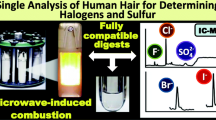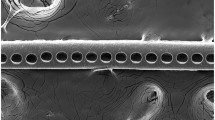Abstract
An approach for high throughput reliable multielemental analysis of trace elements in a large number of horse hair samples was designed. Suitability of time-of-flight mass spectrometer (oaTOF-ICP-MS) for fast determination of unlimited numbers of isotopes in the low volume samples was demonstrated. Due to quasi-simultaneous capability of the oaTOF-ICP-MS the large number of highly valuated data with unaffected isotopic ratio in a very short time could be obtained. The choice of horse hair was obvious because of easy reachability and clear conception about horse nutritional habits and stabling. Such large data set with preserved isotopic ratios is ideal for statistical evaluation which could reveal some interesting interconnection between elemental composition of horse hair and the way of stabling, feeding, etc. Statistical treatment of the data is not a part of this study and will be presented later. We collected one hundred horse hair samples from horse stables through Czech Republic. Samples were washed by optimized washing process to eliminate exogenic contamination prior to digestion and following analysis. A determination of 36 elements (As, Au, B, Be, Cd, Ce, Co, Cr, Dy, Er, Eu, Ga, Gd, Ge, Ho, La, Li, Lu, Nd, Ni, Pb, Pd, Pr, Pt, Rb, Sb, Sc, Sm, Ta, Tb, Te, Tm, U, V, Y, Yb) in horse hair by oaTOF-ICP-MS was optimized. A throughput of 100 samples with unlimited numbers of isotopes per 6 h was achieved. Proposed very fast multielemental method preserves isotopic ratios, and therefore, is undoubtedly highly suitable for statistical studies. Detection limits of the proposed method ranged from 0.13 μg kg−1 (Eu, Gd, Tm) to 27.9 μg kg−1 (Au), except for Ni (48.5 μg kg−1) that is probably affected by contamination raised from nickel cones.

Similar content being viewed by others
References
Anielski P et al (2005) Detection of testosterone, nandrolone and precursors. Anal Bioanal Chem 383:903–908. doi:10.1007/s00216-005-0104-8
Armelin MJA, Ávila RL, Piasentin RM, Saiki M (2001) Application of neutron activation analysis to evaluate the health status of equines by means of Cu, Fe, Mn and Zn determinations in their hair. J Radioanal Nucl Chem 249:417–419. doi:10.1023/A:1013239224784
Asano K, Suzuki K, Chiba M, Sera K, Asano R, Sakai T (2002) Concentrations of toxic metals and essential minerals in the mane hair of healthy racing horses and their relation to age. J Vet Med Sci 64:607–610. doi:10.1292/jvms.64.607
Asano K, Suzuki K, Chiba M, Sera K, Matsumoto T, Asano R, Sakai T (2005a) Influence of the coat color on the trace elemental status measured by particle–inducted X-ray emission in horse hair. Biol Trace Elem Res 103:169–176. doi:10.1385/BTER:103:2:169
Asano K, Suzuki K, Chiba M, Sera K, Asano R, Sakai T (2005b) Twenty-eight element concentrations in mane hair samples of adult riding horses determined by particle-inducted X-ray emission. Biol Trace Elem Res 107:135–140. doi:10.1385/BTER:107:2:135
Asano K, Suzuki K, Chiba M, Sera K, Asano R, Sakai T (2006) Relationship between trace elements status in mane hair and fibrillation in horse. J Vet Med Sci 68:769–771. doi:10.1292/jvms.68.769
Baysal A, Akman S (2010) Determination of lead in hair and its segmental analysis by solid sampling electrothermal atomic absorption spectrometry. Spectrochim Acta 65:340–344. doi:10.1016/j.sab.2010.02.016
Borgese L, Zacco A, Bontempi E, Pellegatta M, Vigna L, Patrini L, Riboldi L, Rubino FM, Depero LE (2010) Use of total reflection X-ray fluorescence (TXRF) for the evaluation of heavy metal poisoning due to the improper use of a traditional ayurvedic drug. J Pharm Biomed Anal 52:787–790. doi:10.1016/j.jpba.2010.02.030
Chandola LC, Lordello AR (1983) Elemental analysis of horse hair by optical emission spectroscopy. Microchem J 28:87–90. doi:10.1016/0026-265X(83)90032-2
Chojnacka K, Górecka H, Chojnacki A, Górecki H (2005) Inter-element interactions in human hair. Environ Toxicol Pharmacol 20:368–374. doi:10.1016/j.etap.2005.03.004
Chojnacka K, Górecka H, Górecki H (2006) The influence of living habits and family relationships on element concentrations in human hair. Sci Total Environ 366:612–620. doi:10.1016/j.scitotenv.2005.12.005
Dunnett M (2005) Hair analysis for screening horses for exposure to dietary toxic residues. Pferdeheilkunde 21:457–467
Dunnett M, Lees P (2003) Trace element, toxin and drug elimination in hair with particular reference to the horse. Res Vet Sci 75:89–101. doi:10.1016/S0034-5288(03)00074-2
Esteban M, Castano A (2009) Non-invasive matrices in human biomonitoring: a review. Environ Int 35:438–449. doi:10.1016/j.envint.2008.09.003
Kazi TG, Jamali MK, Arain MB, Afridi HI, Jalbani N, Sarfaz RA, Ansari R (2009) Evaluation of an ultrasonic acid digestion procedure for total heavy metals determination in environmental and biological samples. J Hazard Mater 161:1391–1398. doi:10.1016/j.jhazmat.2008.04.103
Kolacz R, Bodak E, Dobrzanski Z, Patkowska-Sokola B (1999) Trace elements in the wool of Polish merino sheep grazed in polluted and unpolluted environment. J Anim Sci 44:509–514
Madejón P, Domínguez MT, Murillo JM (2009) Evaluation of pastures for horses grazing on soils polluted by trace elements. Ecotoxicology 18:417–428. doi:10.1007/s10646-009-0296-3
Patkowska-Sokola B, Dobrzanski Z, Osman K, Bodkowski R, Zygadlik K (2009) The content of chosen chemical elements in wool of sheep of different origins and breeds. Arch Anim Breed 52:410–418
Rao KS, Bajali T, Rao TP, Babu Y, Naidu GRK (2002) Determination of iron, cobalt, nickel, manganese, zinc, copper, cadmium and lead in human hair by inductively coupled plasma—atomic emission spectrometry. Spectrochim Acta 57:1333–1338. doi:10.1016/S0584-8547(02)00045-9
Ribeiro AS, Curtius AJ, Pozebon D (2000) Determination of As, Cd, Ni and Pb in human hair by electrothermal atomic absorption spectrometry after sample treatment with tetramethylammonium hydroxide. Microchem J 64:105–110. doi:10.1016/S0026-265X(99)00024-7
Rodrigues JL, Batista BL, Nunes JA, Passos CJS, Barbosa F (2008) A fast method for the determination of 16 elements in hair samples by inductively coupled plasma mass spectrometry (ICP-MS) with tetramethylammonium hydroxide solubilization at room temperature. J Anal At Spectrom 23:992–996. doi:10.1039/b800595h
Rodushkin I, Axelsson MD (2000) Application of double focusing sector field ICP-MS for multielemental characterization of human hair and nails. Part I. Analytical methodology. Sci Total Environ 250:83–100. doi:10.1016/S0048-9697(00)00369-7
Sobanska MA (2005) Wild boar hair (Sus scrofa) as a non-invasive indicator of mercury pollution. Sci Total Environ 339:81–88. doi:10.1016/j.scitotenv.2004.07.018
Steely S, Amarasiriwardena D, Jones J, Yanes J (2007) A rapid approach for assessment of arsenic exposure by elemental analysis of single strand of hair using laser ablation-inductively coupled plasma-mass spectrometry. Microchem J 86:235–240. doi:10.1016/j.microc.2007.03.009
Acknowledgements
The authors gratefully acknowledge the financial support of the research plan SGFChT05/2012. Providing samples from all subjects is gratefully appreciated.
Author information
Authors and Affiliations
Corresponding author
Rights and permissions
About this article
Cite this article
Návesník, J., Krejčová, A., Černohorský, T. et al. High throughput method for multielemental analysis of horse hair by oaTOF-ICP-MS. Chem. Pap. 71, 991–998 (2017). https://doi.org/10.1007/s11696-016-0090-7
Received:
Accepted:
Published:
Issue Date:
DOI: https://doi.org/10.1007/s11696-016-0090-7




